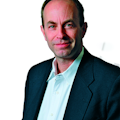CAMBRIDGE, MA - At its 2005 annual meeting in May, the Massachusetts Institute of Technology’s Center for Integrated Photonic Systems (MIT CIPS) once again brought researchers from around the world together with the MIT photonics community. As stated by Rajeev Ram, the director of CIPS, an associate professor at MIT, and the introductory speaker, CIPS is designed to break down barriers between departments at MIT and to move MIT photonics research as quickly as possible into applications.
The first plenary talk, given by Robert Leheny, deputy director of DARPA (the Defense Advanced Research Projects Agency), detailed photonics research at DARPA, which in part aims to create a network of battlefield photonic devices that exploit the full range of the electromagnetic spectrum from UV to terahertz. This network of sensors, processors, and actuators is hand-carried as well as transported by air and ground vehicles. Leheny described some of the research supported by DARPA, including room-temperature IR focal-plane arrays with wavelength-tunable pixels, steered agile light beams consisting of phase-locked emitting elements, fast CMOS sensors, and precision high-Q modelocked optical oscillators that produce widely tunable microwave signals.
Stan Lumish, the chief technical officer of JDS Uniphase (San Jose, CA) outlined the company’s areas of photonics expertise, including intelligent optical networks that can be dynamically reconfigured; thin films for devices including liquid-crystal displays and liquid-crystal on silicon; and interference-based pigments to prevent counterfeiting (see p. 4).
Eli Yablanovitch, professor of engineering at the University of California, Los Angeles and a pioneering photonic-crystal (PC) researcher, discussed upcoming applications of PCs. Because on-chip optical communication would reduce the required energy per bit, PCs may have great use in communications within a computer. He described photonic-bandgap-based “nanophotonic” integrated-circuit elements consisting of cavities with volumes of no greater than 0.005 l3 (where l is the wavelength of the light used) and Q of greater than 6 x 105, with Q of 6 x 106 possible.
Yoel Fink, assistant professor at MIT and one of the developers of the so-called omnidirectional thin-film reflector, spoke about uses of this technology in the IR (he noted that common optical materials don’t meet requirements in the visible). He sees hollow omnidirectional tubes as waveguides for laser-power handling and for telecommunications, and described a tube for carbon dioxide laser light that turns a 90∞ corner. Similar coatings could contain radiative heat in a room and, if made biodegradable, could be coated on food to retain heat.
At the Ultrafast Technology session, Franz Kärtner of MIT discussed current efforts to create arbitrary ultrafast waveforms, as well as on integrated femtosecond sources composed of microchip lasers, glass waveguides, and novel saturable absorbers. He also mentioned the coherent superposition of two modelocked lasers-one Ti:sapphire and the other Cr:forsterite-to create a spectrum spanning 650 to 1450 nm, thus allowing shorter pulses.
At the Large-Area Optoelectronic Integration session, Joe Jacobsen of MIT delved into integrated large-area optoelectronics, which include flexible displays as well as organic photodetector arrays. Here, some photovoltaic-cell-manufacturing methods may be borrowed to reduce costs of large displays. Sigurd Wagner of Princeton University (Princeton, NJ) discussed “smart skin,” or surfaces that in one incarnation sense and may possibly even change properties such as roughness. In other forms, pixelated surfaces consisting of rigid elements on a stretchable substrate can be made relatively durable; stretchable gold films can conduct electricity.
About the Author
John Wallace
Senior Technical Editor (1998-2022)
John Wallace was with Laser Focus World for nearly 25 years, retiring in late June 2022. He obtained a bachelor's degree in mechanical engineering and physics at Rutgers University and a master's in optical engineering at the University of Rochester. Before becoming an editor, John worked as an engineer at RCA, Exxon, Eastman Kodak, and GCA Corporation.
